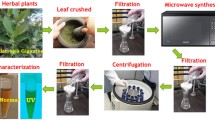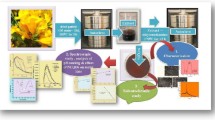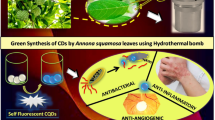Abstract
A novel and facile biogenic method has been developed to synthesize small sized and highly fluorescent zinc sulfide (ZnS) quantum dots (QDs) from the latex of plant Calotropis gigantea. Extraction of milky white latex was done during the early morning hours by cutting the green stems. Quantum dots prepared by this one step method were found to be water soluble and highly stable. The optical properties of ZnS QDs were analyzed by UV–Vis absorption and fluorescence spectroscopy. Fourier transform infrared (FTIR) spectroscopy confirmed the synthesis of ZnS QDs as sharp peak is observed at 693 cm−1 that corresponds to the Zn–S stretching. Size of ZnS QDs was found in the range of 2–3 nm in diameter, and they were spherical in shape. This was further confirmed by the high-resolution transmission electron microscopy (HR-TEM) as well as by X-ray powder diffraction (XRD) studies. Also, sharp and strong diffraction peaks of XRD indicated the excellent crystallinity of the ZnS QDs. The results signify that the proposed ZnS quantum dots could be exploited for bio-sensor, bio-imaging, and drug delivery applications.
Similar content being viewed by others
Avoid common mistakes on your manuscript.
Introduction
Nanotechnology represents a revolutionary path for technological development that concerns the management of material at the nanometer scale (one billion times smaller than a meter). In recent years, nanotechnology has emerged as a multidisciplinary field, in which gaining a fundamental understanding of the electrical, optical, magnetic, and mechanical properties of nanostructures promises to deliver the next generation of functional materials with wide-ranging applications [1]. The concept of QDs was developed in solid (glass crystals) and liquid state by Alexie Ekimov (1981) and Brus (1985), respectively. Term “Quantum dots” was coined by Mark Reed (1988). Quantum dots (QDs) are semiconductor, roughly spherical colloidal particles with nanometer dimension. A single quantum dot generally has hundreds to thousands of atoms [2]. QDs possess outstanding optical properties, such as high quantum yields, high extinction coefficient, broad absorption spectra, narrow and symmetric size-tunable emission, fluorescence intermittency (blinking), and strong resistance to photobleaching, which make them advantageous over traditional fluorophores for biosensing applications [3, 4]. Restricted motion of electrons due to reduction of their size to nanometer level in all dimensions leads to distinct atom like electronic structure along with the size dependent energy levels [5].
Various chemical, physical, and biological techniques are used to synthesize quantum dots. Most of the chemical and physical methods employed for the synthesis involve lethal and flammable organic solvents and harsh reaction conditions such as high temperature and pressure [6]. Furthermore, biologically synthesized quantum dots have superior biocompatibility in comparison to chemically prepared quantum dots. Quantum dots prepared by green synthesis approach have the benefit of being environment friendly, reproducible, and does not involves use of chemicals, unsafe solvents, and surfactants [7].
Calotropis gigantea is a familiar weed plant and xerophytic shrub which is also recognized as giant milk weed. This plant can be found in different parts of world such as Asia (India, China, Malaysia, Thailand, Pakistan, Bangladesh, Philippine, Sri Lanka, and many more), South America (Brazil, Chile, Colombia, Peru, and many more), and Africa. In India, it has diverse vernacular names such as Aak, Arka, Ekka, Erukku, Ganarupa, Mandara, Sadapushpa, Svetapushpa, Vasuka, and so on [8]. The plant has oval, light green leaves, milky stem, and clusters of waxy flowers that are either white or lavender in color. Calotropis gigantea is frequently available in India and used for several medication purposes in traditional medicinal system. Calotropis gigantea belongs to the family Asclepiadaceae and is an ayurvedic plant also known as ‘Sweta Arka” which has important medicinal properties [9] (Table 1).
In this paper, simple, green, and environment friendly method has been presented for the synthesis of zinc sulfide (ZnS) quantum dots from the latex of plant Calotropis gigantea and characterization was done.
Experimental Details
Materials
Milky white latex was collected from plant Calotropis gigantea (shown in Fig. 1) at early morning hours by cutting the green stems [15]. Latex is produced in higher amount at the morning time, and collected latex was stored at − 35 ℃ till further studies.
Zinc acetate analytical grade was purchased from HiMedia, and deionized water was used for the preparation of all the aqueous solutions.
Methods
Synthesis of ZnS Quantum Dots from Latex of Plant Calotropis gigantea
Zinc sulfide (ZnS) quantum dots were prepared by simple, one pot method of synthesis. First of all, 3 mL of the crude latex was diluted to 100 mL by using deionized water to make a solution of 3% v/v [16]. This solution was centrifuged for 5 min at 8000 rpm. The resulting supernatant was used for the synthesis of quantum dots. Then 20 mL of this supernatant was boiled to 50–70 ℃. When temperature reached near to 70 ℃, 2 gm of zinc acetate was added to the boiling supernatant [17]. After 20–25 min, creamish brown color precipitates can be observed. Mixture was boiled till it was reduced to a creamish brown paste. This paste was collected in a ceramic crucible and was heated in an oven for 4–5 h at 50 ℃. Finally, fine powder was collected, and attained powder was very much soluble in water. This was first time that latex of Calotropis gigantea was used for the synthesis of ZnS quantum dots. This stoichiometric quantity was determined based on the preliminary testing with UV–visible spectrophotometer.
Characterization Studies
The synthesized ZnS quantum dots were characterized by using different techniques. UV–visible absorbance spectrum of ZnS QDs was recorded at different time intervals using Chemito Spectrascan UV 2600 double beam UV–Vis spectrophotometer. The quantum dots were diluted in deionized water, and measurements were carried out at room temperature in the absorption range of 200–600 nm. The fluorescence spectrum of ZnS quantum dots was recorded by single beam spectrofluorometer, Cary Eclipse (Agilent) at room temperature. The prepared sample was diluted in deionized water. The crystallinity of ZnS QDs were also studied by X-ray diffraction (XRD) method by means of X-ray diffractometer (Rigaku Smart lab) with CuK alpha radiation k = 1.5404 A˚ and theta range from 10˚ to 90˚. High-resolution transmission electron microscope (HR-TEM) was employed for the structural and morphological analysis of the synthesized QDs by using JEOL-JEM 2100 Plus instrument with tungsten as a source of electron. Firstly, suspension was put through ultrasonication in order to separate the individual particles, and copper grid was layered with drop of ZnS QDs solution and was desiccated in chamber.
Results and Discussions
The shape and structure of biogenic ZnS quantum dots was confirmed by using spectroscopic as well as by sophisticated microscopic analysis. Reduction of zinc (Zn2+) ions and formation of ZnS quantum dots was recognized by the color change of the reaction mixture from white to creamish brown. Furthermore, quantum dots synthesis was confirmed by exposing them to UV light after preparing the solution in deionized water (Fig. 2).
Optical properties of the prepared ZnS quantum dots were analyzed by UV–visible absorption spectrum. It was performed by scanning the wavelength from 200 to 600 nm by preparing the aqueous solution, and the typical absorbance peak was found at the wavelength of 204 nm as shown in Fig. 3a. Comparable results have been provided by Neelam et al. for the synthesis of ZnS quantum dots [18, 19]. High fluorescence nature of ZnS quantum dots was confirmed by the emission spectrum. The emission peak was observed at 335 nm as shown in Fig. 3b. It was due to radiative property, quantum effect, emission traps, and high surface area of quantum dots. Additionally, X-ray diffraction method was employed to determine the crystal lattice as well as phase purity of ZnS quantum dots. Three distinguished peaks of homocentric zinc blende composition or sphalerite arrangement were observed correspondingly at 2θ of 11.9098°, 19.5118°, and 24.2468°. The X-ray diffractogram as well as 2θ values were close to that of JCPDS Card No: 89–2425, and graph is shown in Fig. 3c [20]. It was found that ZnS quantum dots have excellent crystallinity as indicated by the sharp as well as strong diffraction peaks. Also, it was inferred that quantum dots synthesized have high purity as additional peaks were not observed in the XRD graph. The wurtzite along with sphalerite structural forms of ZnS have previously been described and were biosynthesized by green methods such as from Fusarium species, Penicillium species in addition to chemical co-precipitation techniques [21, 22]. Scherrer’s equation was used for the estimation of size of ZnS quantum dots, and it was found that the results obtained from XRD and HR-TEM were reasonably comparable. Dhkl that is the mean crystalline size of ZnS quantum dots can be determined by means of Scherrer’s equation [23]:
a UV–Vis spectra of ZnS QDs (λex = 204 nm) at two different concentrations (3 ppm and 5 ppm), b Fluorescence spectra of ZnS QDs (λemm = 335 nm), c XRD pattern of the synthesized ZnS QDs and three peaks of homocentric zinc blende composition or sphalerite arrangement can be observed with 2θ values of 11.9098°, 19.5118°, and 24.2468°, d FTIR spectra of ZnS QDs shows variation in stretches that evidently attributes to interaction of ZnS QDs with protein fractions present in latex of plant Calotropis gigantea, e HR-TEM image of ZnS QDs (high magnification image) which indicates that ZnS QDs are spherical in shape, f selected area electron diffraction (SAED) pattern of ZnS QDs with concentric rings represents polycrystalline character of ZnS QDs
- Dhkl:
-
Particle size that is perpendicular to normal line of (hkl) plane
- k:
-
Constant
- \(\uplambda\):
-
Wavelength of X-ray
- βhkl:
-
Full width at half maximum of the (hkl) diffraction peak
- θhkl:
-
Bragg angle of (hkl) peak
Fourier transform infrared spectroscopy was used for the measurement of absorption of infrared radiations (IR) by the sample, and the results are shown by the means of a wavelength [24, 25]. The broad band at 3097 cm−1 is observed due to O–H stretching and small peak at the 2883 cm−1 corresponds to the C-H stretching vibration [26]. The principal band at 1547 cm−1 can be allocated to the symmetric as well as to asymmetric stretching of COO-subsequently. This proves that acetate group is retained in the prepared ZnS quantum dots since zinc acetate was used as a precursor for zinc ions [27]. Another sharp peak can be seen at 1449 cm−1 which can be assigned to the methylene group and its bending vibrations representing C-H bonds. An additional band that confirms the formation of ZnS quantum dots is observed at 693 cm−1 which correspond to Zn–S stretching as shown in Fig. 3d [28]. FE-TEM micrograph depicts that the synthesized ZnS quantum dots are uniformly distributed and are spherical in shape. The average size of quantum dots ranges from diameter 2–3 nm as depicted in Fig. 3e.
Conclusion
We have developed a green, novel, simple, efficient, and low cost method for synthesis of ZnS quantum dots from the latex of plant Calotropis gigantea that are highly fluorescent and possess good stability. These plant-based quantum dots have typical absorption and emission peaks at 204 nm and 335 nm, respectively. The results from HR-TEM and XRD studies indicate that ZnS QDs have crystalline nature with a size of 2–3 nm. Furthermore, an important band in FTIR at 693 cm−1 confirms the formation of ZnS QDs that corresponds to Zn–S stretching. Also, selected area electron diffraction pattern represents concentric rings instead of sharp spots, and they signify polycrystalline nature of ZnS QDs. The crystalline and fluorescent ZnS quantum dots can provide excellent potential for the fabrication of sensors, imaging as well as for drug delivery.
Data Availability
The data presented in the paper are the experimental results obtained during the study.
Code Availability
Not applicable.
References
Nasrollahzadeh M, Sajadi M, Sajjadi M, Issaabadi Z. An introduction to nanotechnology. Interface Sci Technol. 2019;28:1–27.
Reshma VG, Mohanan PV. Quantum dots: applications and safety consequences. J Lumin. 2018. https://doi.org/10.1016/j.jlumin.2018.09.015.
Lia J, Zhu JJ. Quantum dots for fluorescent biosensing and bio-imaging applications. Analyst. 2013;138(9):2506.
Kargozar S, Hoseini SJ, Milan PB, Hooshmand S, Kim HW, Mozafari M. Quantum dots: a review from concept to clinic. Biotechnol J. 2020. https://doi.org/10.10002/biot.202000117.
Arquer FPG, Talapin DV, Klimov VI, Arakawa Y, Bayer M, Sargent EH. Semiconductor quantum dots: technological progress and future challenges. Nanomaterials. 2021;373.https://doi.org/10.1126/science.aaz8541.
Zhou J, Yang Y, Zhang CY. Toward biocompatible semiconductor quantum dots: from biosynthesis and bioconjugation to biomedical application. Chem Rev B. 2015. https://doi.org/10.1021/acs.chemrev.5b00049.
Suresh AK. extracellular bio-production and characterization of small monodispersed CdSe quantum dot nanocrystallites. Spectrochim Acta, Part A. 2014;130:344–9.
Kumar S, Suresh E, Kalavathy S. Review on a potential herb Calotropis gigantea (L.). R Br Sch Acad J Pharm. 2013;2(2):135–143.
Chitme HR, Chandra R, Kaushik S. Studies on anti-diarrheal activity of Calotropis gigantea R.Br. in experimental animals. J Pharm Pharmaceut Sci. 2004;7(1): 70–75.
Pal G, Sinha NK. Isolation, crystallization, and properties of calotropins DI and DII from Calotropis gigantea. Arch Biochem Biophys. 1980;202(2):321–9.
Saratha V, Iyyam Pillai S, Subramanian S. Isolation and characterization of Lupeol, a triterpenoid from Calotropis gigantea latex. Int J Pharm Sci Rev Res. 2011;10(2):54–7.
Atef GH, Elgamal MHA, Morsy NAM, Duddeck H, Kovacs J, Toth G. Two cardenolides from Calotropis procera. J Magn Reson Chem. 1999;17:754–7.
Thakur S, Das P, Itoh T, Imai K, Matsumoto T. Latex extractables of Calotropis gigantea. Phytochemistry. 1984;23(9):2085–7.
Kumar G, Karthik L, Rao KVB. A review on pharmacological and phytochemical profile of Calotropis Gigantea Linn. Pharmacologyonline. 2011;1:1–8.
Rajkuberan C, Sudha K, Sathishkumar G, Sivaramakrishnan S. Antibacterial and cytotoxic potential of silver nanoparticles synthesized using latex of Calotropis gigantea L. Spectrochim Acta Part A Mol Biomol Spectrosc. 2014. https://doi.org/10.1016/j.saa.2014.09.115.
Hudlikar M, Joglekar S, Dhaygude M. Kodam K (2012) Latex-mediated synthesis of ZnS nanoparticles: green synthesis approach. J Nanopart Res. 2012;14:865.
Vidya C, Hirematha S,Chandraprabha MN, Antonyraja MAL, Gopal IV, Jaina A, Bansal K. Green synthesis of ZnO nanoparticles by Calotropis Gigantea. Int J Curr Eng Technol. 2013;ISSN 2277 – 4106.
Verma N, Singh AK, Saini N. Synthesis and characterization of ZnS quantum dots and application for development of arginine biosensor. Sens Bio-Sens Res. 2017. https://doi.org/10.1016/j.sbsr.2017.07.004.
Papadopoulou A, Chalmpes N, Gournis D, Kostopoulou N, Efthimiadou EK. Synthesis, characterization and evaluation of aqueous Zn-based quantum dots for bioapplications. Dalton Trans. 2022;51:3452–61.
Jacob JM, Rajan R, Aji M, Kurup GG, Pugazhendhi A. Bio-inspired Zns quantum dots as efficient photo catalysts for the degradation of methylene blue in aqueous phase. 2018. https://doi.org/10.1016/j.ceramint.2018.11.182.
Delgado NF, Herrera M, Tavabi A, Luysberg M, Borkowski RD, Rodriguez-Cantó P, Abargues R, Martínez-Pastor J, Molina S. Structural and chemical characterization of CdSe-ZnS core-shell quantum dots. Appl Surf Sci. 2018;457:93–7.
Mirzadeh S, Darezereshki E, Bakhtiari F, Fazaelipoor MH, Hosseini MR. Characterization of zinc sulfide (ZnS) nanoparticles biosynthesized by Fusarium oxysporum. Mater Sci Semicond Process. 2013;16:374–8.
Godavarti UD, Nagaraju P, Yelsani V, Pushukuri Y, Reddy PS, Dasari M. Synthesis and characterization of ZnS-based quantum dots to trace low concentration of ammonia. J Seminconductors. 2021;42:122901.
Goharshadi EK, Sajjadi SH, Mehrkhah R, Nancarrow P. Sonochemical synthesis and measurement of optical properties of zinc sulfide quantum dots. Chem Eng J. 2012;209:113–7.
Rajashekara S, Shrivastava A, Sumhitha S, Kumari S. Biomedical applications of biogenic zinc oxide nanoparticles manufactured from leaf extracts of Calotropis gigantea (L.) dryand. BioNanoScience. 2020. https://doi.org/10.1007/s12668-020-00746-w.
Shahi AK, Pandey BK, Singh BP, Gupta BK, Singh S, Gopal R. Photo physical studies of PVP arrested ZnS quantum dots. Electron Mater Lett. 2016. https://doi.org/10.1007/s13391-017-6132-7.
Kumar S, Singhal M, Sharma JK. Functionalization and characterization of ZnS quantum dots using biocompatible L-cysteine. J Mater Sci: Mater Electron. 2013. https://doi.org/10.1007/s10854-013-1332-x.
Baruah JM, Kalita S, Narayan J. Green chemistry synthesis of biocompatible ZnS quantum dots (QDs): their application as potential thin films and antibacterial agent. Int Nano Lett. 2019;9:149–59.
Acknowledgements
The authors wish to thank CSIR, Punjabi University Patiala, Modi Education Society, and Dr. Khushvinder Kumar, Principal, M.M. Modi College, Patiala, India, for the encouragement.
Author information
Authors and Affiliations
Corresponding author
Ethics declarations
Conflict of Interest
There are no conflict of interest.
Human and Animal Rights and Informed Consent
This article does not contain any studies with human and animal subjects performed by any of the authors.
Additional information
Publisher's Note
Springer Nature remains neutral with regard to jurisdictional claims in published maps and institutional affiliations.
This article is part of the Topical Collection on Natural Products: From Chemistry to Pharmacology
Rights and permissions
Springer Nature or its licensor (e.g. a society or other partner) holds exclusive rights to this article under a publishing agreement with the author(s) or other rightsholder(s); author self-archiving of the accepted manuscript version of this article is solely governed by the terms of such publishing agreement and applicable law.
About this article
Cite this article
Kaur, G., Bhari, R. & Kumar, K. Novel and Green Method for Synthesis of Fluorescent ZnS Quantum Dots from Latex of Plant Calotropis gigantea. Curr Pharmacol Rep 9, 1–6 (2023). https://doi.org/10.1007/s40495-022-00311-x
Accepted:
Published:
Issue Date:
DOI: https://doi.org/10.1007/s40495-022-00311-x







